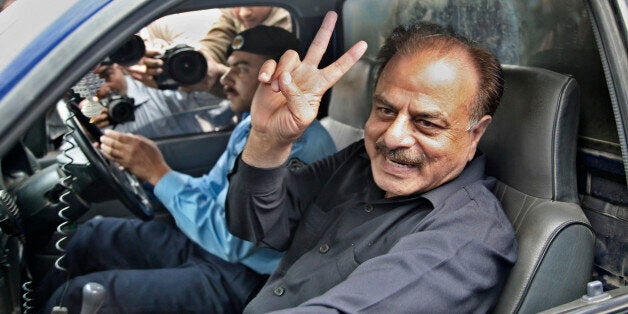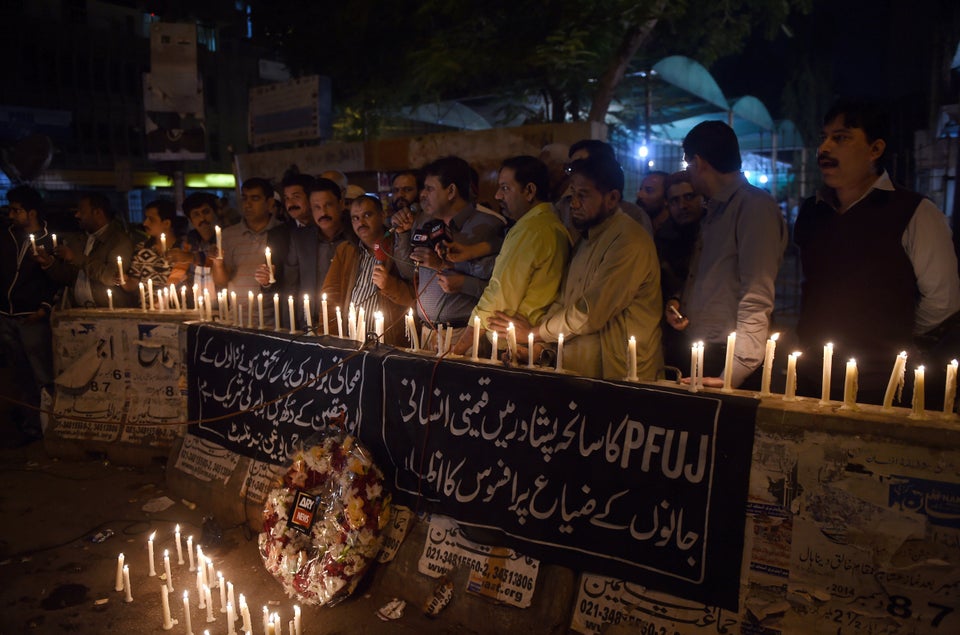
Lt. Gen. Hamid Gul passed away over a week ago. He was perhaps the most vocal Pakistani jihadist general after his former boss, General Muhammad Zia ul-Haq, with whom he shared his Islamist zealotry and now the month of death. Both were equally verbose and fanatical, but General Gul's boisterous bravado contrasted sharply with General Zia ul-Haq's sly viciousness. Like Zia, Gul was a pan-Islamist fundamentalist in thought and had no qualms about achieving those ends through jihadist means and terrorist proxies. He ratcheted up the jihadist incubator that his predecessors had started -- all the way. While Zia wanted to keep the "Afghan pot simmering," Gul was not shy of bringing it to a full boil.
Gul epitomized everything that is wrong -- or right depending on which side of a suicide bomber's vest one's loved ones are on -- with using jihadist terrorism as a tool of foreign policy. He did not make jihadism the cornerstone of Pakistan's Afghan and India policy, but he certainly was its most outspoken advocate and practitioner. His 1987-1989 stint as the director general of the Inter-Services Intelligence agency was the high-water mark of his otherwise lackluster military career. And even for those two "golden years" he could only show a crushing military defeat at Jalalabad and blatant political subversion and massive jihadist blowback at home. His subordinate and the then in-charge of the ISI-backed Afghan mujahideen assault on Jalalabad, Brigadier Mohammed Yousaf, was to write later in his book, "The Bear Trap: The Defeat of a Superpower":
General Gul was removed from his post at ISI in June 1989, when it was clear to everybody that Jalalabad was a catastrophe. His two year involvement with the Jihad must have been a bitter experience for him. He came at a time when military victory was in sight; he left when Mujahideen defeat was distinctly possible.
Gul, a former cavalryman, was never to win a set-piece military engagement in his life despite insisting to the then Prime Minister Benazir Bhutto that Jalalabad would "fall within a week." And when the late Benazir Bhutto dithered before eventually authorizing the assault, Gul was livid. The respectable military historian Shuja Nawaz chronicles that Gul told her, "You cannot deny us the drive into Kabul in victory to pray at the Kabul mosque." As the former Zia-ul-Haq associate General (retired) Khalid Mahmud Arif notes in his book, "Working with Zia: Pakistan's Power Politics, 1997-1988": "Bhutto['s] administration had a different policy on Afghanistan. She spoke of the futility of the Mujahideen operations. . . with wavering political support and a lack of professional guidance, the ISI Directorate was left alone to handle the workload. In early 1989, egged on by the CIA, the ISI Directorate committed the Mujahideen to a conventional military attack for capture of Jalalabad." The humiliation he and his henchmen suffered in the spring and summer of 1989 at Jalalabad was immediate, utter and quite public. According to Brigadier Yousaf's account, 3,000 jihadists were killed or wounded. We, in Peshawar, saw firsthand the scores of injured mujahideen being brought to the Arab-run hospitals mostly situated along the University Road after the Afghan army pummeled them in the outskirts of Jalalabad. Saudi and Kuwaiti Red Crescent hospitals littered the city's artery leading to the Pak-Afghan border crossing back then. At that time an Arab orthopedics and trauma surgeon named Ayman al-Zawahiri practiced out of one of those facilities. The terror mastermind needs no introduction today and neither does his leader Osama bin Laden, who was among General Hamid Gul's hordes descending upon Jalalabad.
While political intrigue and transnational jihadism remain Gul's lasting legacies, perhaps a major lesson is that while doing business with unsavory characters can be expedient, it is surely not without disastrous consequences.
Indeed, bin Laden's participation in Jalalabad attack has been a part of the al-Qaeda lore since. Shuja Nawaz accurately notes in his book "Crossed Swords: Pakistan, Its Army, and the Wars Within," "a footnote in this operation was the inclusion in the battle for Jalalabad -- unbeknownst to most participants at the Peshawar meeting -- of a young Saudi financier and Islamic militant named Osama bin Laden." Benazir Bhutto and the then U.S. ambassador to Pakistan, the late Robert Oakley, had attended that meeting in Pakistan while no Afghan -- not even the mujahideen -- was reported to have been present there. General Hamid Gul was to strike politically against the Bhutto government that same year while bin Laden launched his first terrorist attacks against the U.S. embassies in Nairobi and Dar es Salaam within a decade. While political intrigue and transnational jihadism remain General Hamid Gul's lasting legacies, perhaps a major lesson is that while doing business with unsavory characters can be expedient, it is surely not without disastrous consequences. The former DG ISI was working closely with the U.S. operatives and administration who were eager to defeat the Soviet Union in Afghanistan back then. In their eagerness, the U.S. officials seemed to overlook or underplay Gul's extremely obvious jihadist bent and ties to the Afghan fundamentalists like Gulbuddin Hekmatyar, who happened to be his choice to lead that assault on Jalalabad as well. Shuja Nawaz has cited Gul as saying that the CIA officials offered to arrange for his son's education in the U.S. and telling him, when he declined it, that they had done so for all the children of his predecessor General Akhtar Abdur Rahman. With General Gul's demise his then CIA interlocutor Milton Bearden perhaps remains the only one to accept or reject the veracity of the late general's claim.
The team working under Gul at the time also included Colonel Amir Sultan Tarar aka Colonel Imam who was to later play a large role in the creation of the Afghan Taliban only to be allegedly killed a decade later by the leader of Pakistani Taliban after they fell out with each other. And it was not that the warning signs of the U.S. backing a reckless jihadist were not there. Indeed, detailed reports were written by the U.S. officials like the State Department special envoy Edmund McWilliams. Steve Coll notes in his masterpiece "Ghost Wars: The Secret History of the CIA, Afghanistan, and Bin Laden, from the Soviet Invasion to September 10, 2001":
THE BLOODY DISASTER (sic) at Jalalabad only deepened Ed McWilliams's conviction that the CIA and ISI were careening in the wrong direction. He could not understand why (the U.S. Ambassador Robert) Oakley tolerated Bearden's (CIA's Islamabad station chief) collaborations with Pakistani intelligence and its anti-American clients, especially Hekmatyar and Sayyaf.
Fast forward 26 years and it is not difficult to see the U.S. officials just way too eager to be duped by whiskey-chugging, jihad-peddling Pakistani generals. One need not look farther than Mullah Omar's case where Pakistan, by all indication, successfully deceived the U.S. and protected the one-eyed Taliban leader while his hordes killed Afghan and American men and women. Falling for English-speaking Pakistani generals like Hamid Gul while ignoring their jihadist and blatantly anti-democratic agenda has done irreparable harm to the U.S. chances of prevailing over the Taliban in Afghanistan and emboldened those generals to take on their country's civilian dispensation routinely and openly. The navy-blazer-donning heavy-smoking General Hamid Gul had an avowed dislike for democracy and particularly the late Benazir Bhutto and her Pakistan Peoples Party. He tried to keep her out of power by engineering a right-wing coalition Islamic Democratic Alliance right before the 1988 elections. She was appalled by him and his maneuvering and wrote in her last book "Reconciliation: Islam, Democracy, and the West": "In 1988, the electoral deck was stacked against the PPP. The state-controlled media were clearly hostile to the forces of democracy. . . Almost unlimited amounts of money poured in from the ISI to fund the IJI campaign." Bhutto was able to form a coalition federal government, but the IJI's success in Punjab dialed Pakistan's national political dial to the right for good.
The campaign run by the General Gul-backed IJI was nasty and misogynist and tainted by personal vitriol against Benazir Bhutto. As a young secular political activist back then, I had the misfortune of listening to some of the vitriol against Benazir Bhutto and her mother Nusrat Bhutto. Foul language by the IJI leaders such as Sheikh Rashid Ahmed, doctored photographs of the Bhutto ladies and religious edicts denouncing a woman's leadership as forbidden were widely circulated. She had to cede any say in, let alone have a control over, the national security and foreign policies before she could set foot in the office. She perhaps tried to appease him by allowing misadventures like Jalalabad and later the Taliban enterprise on her watch, but General Gul and his ilk seemed to have it in for her permanently. His subordinate Brigadier Imtiaz Ahmed cobbled together a no-confidence move against the Bhutto government in 1989. Berating politics and politicians and manufacturing dissent through fanatical street mobs and palatial intrigue that General Hamid Gul presided over then has carried over, with the net effect being political instability and uncertainty in which Islamist militancy has thrived without pause.
General Hamid Gul was the military equivalent of Osama bin Laden. He died with his boots on and blood of the innocents on his hands.
In his day, the late general had turned Pakistan virtually into a jihadist Noah's Ark with assorted mercenary fanatics arriving in droves and unleashing havoc in Afghanistan. He was proud and unrepentant about it. He did eventually make it to Kabul as a guest of the Taliban regime after Mullah Omar overran the Afghan capital. Gul later midwifed the transition of the jihadist mercenaries from Kabul to Kashmir. The Taliban regime-controlled Afghanistan served as training grounds for various Kashmir-oriented jihadists like Lashkar-e-Taiba and also the sectarian terrorist outfits like the Lashkar-e-Jhangvi. Gul unabashedly shared the stage with the ringleaders of these outfits at forums like the Defense of Pakistan Council. He continued to root for the Taliban, al Qaeda and Pakistan's India-oriented jihadists without any restraint for decades. Gul was perhaps the least mysterious of spymasters. He carried himself with a swagger that appeared compensatory and was quick to blurt out his jihadist creed.
For almost a quarter century post-retirement General Gul had remained a permanent fixture in the Pakistani media and practically was the bellwether of those sections of the Pakistani military establishment that were given to intrigue and ideologically-anchored adventurism. Any illusions about that country's paradigm shift should take into account that the incumbent army chief General Raheel Sharif the Kashmiri jihadist Syed Salahuddin both attended Gul's funeral. Imbued with his zealotry General Hamid Gul helped sow a jihadist wind in Afghanistan and Pakistan for which the innocents in both countries ended up reaping a whirlwind. The Ojhri Camp arms depot disaster that happened on Gul's watch in 1988 killed hundreds of Pakistanis in the twin cities of Islamabad and Rawalpindi, including a sitting minister Mr. Khaqan Abbasi. Brigadier Yousaf notes that one reason for Ojhri Camp's massive fallout was that instead of using it as a transit facility, Gul had decided to stockpile weapons before releasing them to the mujahideen. The Ojhri Camp inquiry conducted by General Imranullah Khan was never made public.
General Hamid Gul was the military equivalent of Osama bin Laden. He died with his boots on and blood of the innocents on his hands. One must never speak ill of the dead; it is the jihadist life and legacy of General Hamid Gul, however, which is impossible to ignore if further bloodshed and mayhem in Pakistan and the region is to be averted. Dr. Mohammad Taqi is a columnist for the Daily Times, Pakistan. He can be reached via email: mazdaki@me.com or Twitter @mazdaki.
Earlier on WorldPost:
